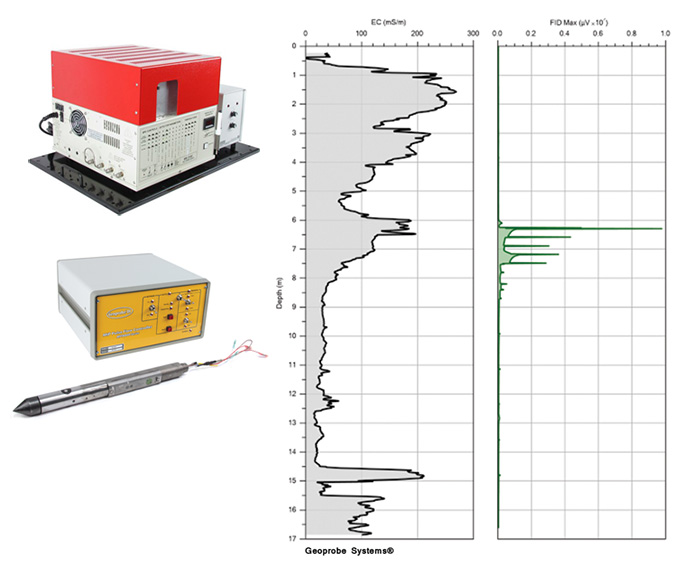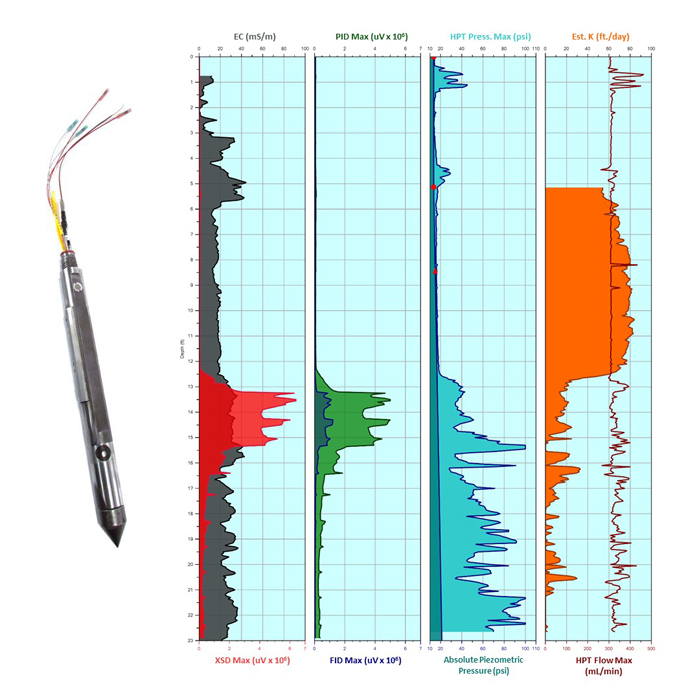Membrane Interface Probe (MIP)
 The membrane interface probe (MIP) is a screening tool used to log the relative concentration of volatile organic compounds (VOCs) with depth in soil. The probe is robust and percussion driveable (hammerable) with direct push machines. The MIP membrane is comprised of a semi-permeable, thin film polymer impregnated into a stainless steel screen for support. The membrane is placed in a heated block that is advanced into the soil. Matrix uses a photoionization detector (PID), a flame ionization detector (FID), and a halogen specific detector (XSD) in our systems. The downhole permeable membrane serves as an interface to the detectors at the surface. With heat, volatiles diffuse across the membrane and partition into a stream of carrier gas where they are swept to the detectors. The MIP acquisition software logs detector signal with depth.
The membrane interface probe (MIP) is a screening tool used to log the relative concentration of volatile organic compounds (VOCs) with depth in soil. The probe is robust and percussion driveable (hammerable) with direct push machines. The MIP membrane is comprised of a semi-permeable, thin film polymer impregnated into a stainless steel screen for support. The membrane is placed in a heated block that is advanced into the soil. Matrix uses a photoionization detector (PID), a flame ionization detector (FID), and a halogen specific detector (XSD) in our systems. The downhole permeable membrane serves as an interface to the detectors at the surface. With heat, volatiles diffuse across the membrane and partition into a stream of carrier gas where they are swept to the detectors. The MIP acquisition software logs detector signal with depth.
Features of the MIP
- Logs VOC contaminants and soil electrical conductivity (EC) with depth
- Shows distribution and relative magnitude of VOC contaminants
- Real time mapping of petroleum and chlorinated VOC plumes
- Used worldwide for characterization of subsurface VOC contaminants Only tool capable of logging VOCs in-situ in real time
Targeted Contaminants with MIP
The XSD is highly specific to halogenated compounds and is used for logging chlorinated solvent plumes or source areas (TCE, PCE, Carbon Tet, etc.). The PID provides sensitivity to aromatic compounds (BTEX) as well as confirmation of chlorinated ethylene compounds detected by the XSD. The FID is a general detector useful for hydrocarbon detection as well as confirmation of high concentration of all compounds seen on the other two detectors.
Low Level MIP (LL MIP)
Low Level MIP (LL MIP) greatly increases the sensitivity (and therefore utility) of the MIP. The technology results in an increase in the concentration of VOC contaminant delivered to the MIP detectors and is most useful when low contaminant concentrations are present.Low level MIP does not replace standard MIP logging; rather, it expands MIP capabilities. LL MIP is most useful when low contaminant concentrations are present. Projects with contaminant concentrations too low to proceed with traditional MIP methods may be good candidates for investigation using the LL MIP method. This technology provides the ability to track and map contaminant plumes down to concentrations at or below the 100ppb range for some contaminants.
Membrane Interface Probe (MIP) / Hydraulic Profiling Tool - Combined Tool
 The membrane interface probe / hydraulic profiling tool (MiHpt) is a combination probe that can perform MIP, HPT, and EC measurements in one push.
The MiHpt probe detects volatile contaminants with the MIP, measures soil electrical conductivity with a standard dipole array, and measures HPT injection pressure using the same down-hole transducer as the stand-alone HPT system. In post-processing the log data, the practitioner is able to estimate hydraulic conductivity (K) and water table elevation, as well as prepare graphical outputs of the log data.
The membrane interface probe / hydraulic profiling tool (MiHpt) is a combination probe that can perform MIP, HPT, and EC measurements in one push.
The MiHpt probe detects volatile contaminants with the MIP, measures soil electrical conductivity with a standard dipole array, and measures HPT injection pressure using the same down-hole transducer as the stand-alone HPT system. In post-processing the log data, the practitioner is able to estimate hydraulic conductivity (K) and water table elevation, as well as prepare graphical outputs of the log data.